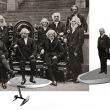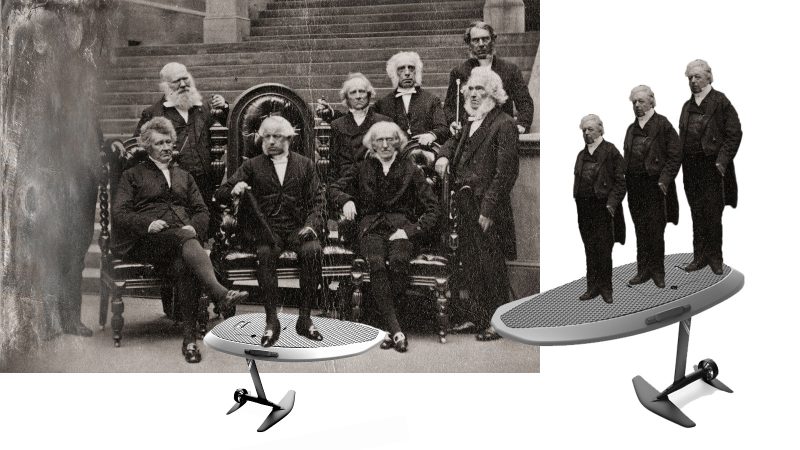Hydrofoils used to be something that was only used on ships and boats, but it turns out that they also make great upgrades for surfboards. Slap on an electric motor, a propeller, and a wireless control panel, and you’ve got yourself an eFoil — a fun transportation device for lovers of outdoor water sports. The design keeps the hydrofoil and propeller beneath the surface of the water and the board high above the waves, so it encounters almost no wave resistance and makes you feel like you’re flying.
If you want to try something totally new out on the water but feel intimidated by the vast selection of options on the eFoil market, don’t worry. Our checklist is going to give you an overview of the most popular boards to help you make an informed decision.
The board’s size and volume
The bigger you are, the bigger the board you need. It’s also easier for beginners to keep their balance on a heavier, larger board. They also allow you to start from the pier on your feet. Light, compact boards force you to lie on your stomach or kneel until the eFoil gets up to speed and stabilizes.
Lighter, shorter foils are good for smaller people and experienced riders. Small boards can reach higher speeds and make sharper turns. They’re also much easier to transport and store. Board volumes are measured in liters and range from 50 to 200. Electric foils up to 80 liters are for experienced riders, while 90 liters or more is best for beginners.
Inflatable vs. Rigid
Inflatable boards are easy to store and transport, but they have to be pumped up every time before riding. Learning to ride them is easy because they are stable, but they don’t go very fast. An inflatable board is also the right choice if you have a small car that can’t fit a full-sized foil inside.
Rigid boards are faster and easier to use, but require lots of trunk space or roof rack to transport them.

Battery Capacity
This determines how far and long you can ride. A battery can last from 20 minutes to 3 hours. Obtaining a full charge from a 220V electrical socket can take between 2 and 4 hours. Look for an eFoil with a removable battery so you can buy extra batteries to ride longer without needing to recharge.
Battery capacity also affects the foil’s top speed. How quickly it drains is determined by the weight of the board and the rider. The lighter you are, the higher the speed and the longer the battery will last.
Along with battery capacity measured in mAh, manufacturers will also usually indicate the range, maximum speed, and duration of a single charge.
Mast Length
Short masts are considered to be 20-24 inches long, while long masts are 32 inches or more.
A long mast lifts the rider higher out of the water, but it’s a bit harder to balance on an eFoil with one. Boards with short masts are smaller, more compact, and easier to transport.
If you plan to ride in shallow water with small waves, then you don’t need a long mast. For the open ocean and large rivers, a longer mast is needed to keep strong waves from crashing against the board.

The Size and Shape of the Hydrofoil
The type of hydrofoil wings attached to the mast determines how the board moves, including its top speed and maneuverability.
The front wing is wider and thicker than the tail wing and is the one that determines how the board moves. The larger its area, the faster the electrofoil will rise above the water and the more stable it will be. It’s easier to learn on, saves on battery life, and is great for long, leisurely rides. Small front wings allow for sharp turns and high speeds, making them the choice of experienced riders.
Wing size is usually measured in square inches. A rider weighing more than 175 lbs will need 200 sq. inches. If you weigh less than 175, a 150-170 square inch wing will suffice.
Top eFoil Brands and Models
Fliteboard

Founded in Australia by world champion kitesurfer David Trevern, this company has been making eFoils since 2016. It now has offices in Australia, the Netherlands, and the US, with 200 authorized dealers around the world.
The manufacturer produces 4 models of electrofoil that can reach speeds of 12 to 25 mph and come in various volumes:
- Fliteboard (100L) — a universal board for all types of riding styles
- Pro (67L) and Ultra (54L) for extreme riders
- Air (150 L) — an inflatable board for beginners and heavy riders
Fliteboard also makes 24 and 30 inch masts, 10 types of wings, and 2 types of batteries (for 60 and 90 minutes of riding).
Prices for a Fliteboard eFoil start at $12,595, not including taxes and shipping costs.
| Pros | Cons |
| A long-lasting charge — up to 90 minutes. | The boards are relatively heavy |
| Maneuverable boards that are easy to control even for beginners. | Not many control settings |
| Expensive |
Lift

These guys invented the hydrofoil and released their eFoil back in 2013.
The Lift 3 4’9” Sport is an eFoil that combines excellent stability with speed. These boards are great for both experienced riders and beginners. It’s compact, so it’s easy to transport, light, and stable. A single battery charge can get you up to 180 minutes of riding time while reaching speeds of 30 mph.
The Lift 4’2” Pro is intended for advanced riders. It’s very agile, stable, and sensitive to the slightest movements of the rider. Ride time can be up to 120 minutes, also at 30 mph.
The Cruiser Lift eFoil 5’4” is a highly durable, rigid board for choppy waters. It’s also one of the fastest in the market. A single battery charge will last between 20 and 40 minutes with speeds up to 34 mph.
When buying Lift electric foils, you can choose mast length, the dimensions of the front and rear wings, and the color of the board edging.
| Pros | Cons |
| Long rides on a single charge | High prices starting at $12,500 per board |
| Lightweight and maneuverable boards |
Mantafoil

This manufacturer makes cheap carbon and inflatable boards in China for beginners and pros.
The carbon boards come in 65 and 95-liter variants that can support riders weighing up to 185 and 200 lbs, respectively. The inflatable boards have volumes of 110 and 145 liters are suitable for riders weighing up to 200 lbs. All boards except for the Carbon 65L are good for beginners.
The Mantafoil Volt eFoil accelerates to a speed of 28 mph. The Volt Pro’s unique mast design uses an underwater propeller as part of the mast, with the wings attached to the propeller. Moreover, it’s possible to use Volt Starter as a plain hydrofoil if you remove the propeller.
You can choose the size of the front wing, the color of the carbon board, the battery capacity (with various capacities from 80 to 140 minutes) and a spare battery.
| Pros | Cons |
| Less expensive: starting at $6295 per set | If your Volt Pro hits some rocks on the bottom, you’ll be damaging an expensive propeller instead of cheap wings |
GetFoil

This manufacturer is new on the scene. They have a cool website and 3 types of boards in 5 different colors.
Foil is an eFoil for beginners with a top speed of 28 mph and a 2.5-hour battery life.
The Foil X is a short, lightweight carbon fiber board for a fast, maneuverable ride. It can go up to 3 hours on a single battery with speeds up to 30 mph.
The Foil R can hit speeds up to 35 mph and ride up to 3 hours. This eFoil is equipped with a 9 horsepower racing engine and a light, rigid composite board.
| Pros | Cons |
| Cheap – starting at $4999 per board | Engine power is the only customizable option |
| Long ride times | Purchase doesn’t include mast and hydrofoil selection |
| Fast-charging batteries (120 mins) |
Takuma

This eFoil is a joint project of French, Japanese, and Spanish engineers and riders. The company’s headquar is in France while production takes place in Japan. The company produces hydrofoils as well as eFoils.
The Takuma Efoil Cruising 2, with a capacity of 190 liters and a short 20-inch mast, is suitable for calm waters, beginners, and experienced riders. It can reach a speed of 18 mph.
The Takuma E-foil Carver 2 is an agile foil with a 25-inch mast designed for the open sea and big waves.
The manufacturer produces 2 types of spare batteries: one for 20-40 minute rides, and one for 70-90 minutes of continuous riding.
| Pros | Cons |
| Less expensive than its competitors at $7,700 for the “Cruising” | Not the fastest of boards |
| A robust design with a minimal amount of moving parts | A short battery life |
Now you are ready to choose the eFoil that’s right for you. We’re including a checklist below that lists everything you should consider before making a purchase. But even if you don’t make the best choice, eFoils have a modular design that allows you to swap out various parts to increase speed and enhance the amazing feeling of hovering over the water.
| Main Characteristics | Top Manufacturers |
| □ Board volume | □ Fliteboard |
| □ Inflatable or rigid? | □ Lift |
| □ Battery capacity | □ Mantafoil Volt |
| □ Mast length | □ GetFoil |
| □ Front hydrofoil size | □ Takuma |



